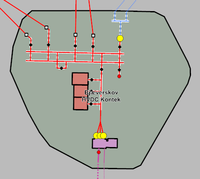Pl:Tag:power=substation
| Opis |
|---|
| Miejsce, w którym znajduje się sprzęt do przesyłania i dystrybucji energii elektrycznej, a także sprzęt do transformacji napięcia, kontrola ochrony sieci elektrycznej. |
| Odwzorowanie w OSM Carto |

|
| Grupa: Energetyka |
| Używane na tych elementach |
| Przydatne kombinacje |
|
| Status: zatwierdzony |
| Narzędzia |
Jeśli rozumiesz angielski, proszę pomóż ukończyć to polskie tłumaczenie. Przeczytaj instrukcje dotyczące tłumaczenia tej wiki.
Wydaje się, że nikt nad tym tłumaczeniem obecnie nie pracuje, więc możesz podjąć się tego zadania.
power=substation – służy do oznaczenia podstacji używanej do podniesienia lub obniżenia napięcia voltage=* w elektrycznej sieci zasilającej i z reguły jest powiązana z resztą sieci poprzez linie power=line.
Może zawierać jeden lub więcej transformator power=transformer. Podstacje mogą zajmować teren rozmiaru od małego budynku, przez ogródek do nawet dużych instalacji rozmiaru kilku boisk piłkarskich.
Ten tag nie powinien być używany w miejscach gdzie jest produkowana energia elektryczna. Tam powinien być power=generator. Zobacz stronę wikipedia:Electrical_substation by dowiedzieć się więcej.
Ten tag jest udoskonaleniem power=station, i ma na celu zastąpienie go.
Mapowanie
Oznacz ![]() lub
lub ![]() jako power=substation. Podstacje powinny być raczej mapowane jako obszary. Bardzo małe stacje rozmiaru małego 'kiosku' na terenach zamieszkałych mogą zostać oznaczone jako węzły ale mogą to być także power=transformer ponieważ dużo ludzi tak je nazywa.
jako power=substation. Podstacje powinny być raczej mapowane jako obszary. Bardzo małe stacje rozmiaru małego 'kiosku' na terenach zamieszkałych mogą zostać oznaczone jako węzły ale mogą to być także power=transformer ponieważ dużo ludzi tak je nazywa.
Powiązane tagi:
- name=* Nazwa obiektu
- operator=* Nazwa firmy obsługującej stację.
- voltage=* Największe napięcie tam występujące. (?)
Szczegółowe mapowanie stacji
Uwaga: ta sekcja opisuje zaawansowany schemat tagowania dla stacji. Jest on raczej przeznaczony dla ludzi z wiedzą na temat systemów energetycznych.
Podstacja służy do przełączania obwodów, transformacji napięcia i kilku innych funkcji ważnych dla systemu energetycznego.
Kiedy obiekt powinien zostać oznaczony jako stacja i kiedy powinien zostać oznaczony jako transformator? Podstacje i transformatory mogą być rozróżniane jako:
- power=substation reprezentuje obszar który może zawierać transformatory. Często zawiera rozdzielnice i inne komponenty.
- power=transformer reprezentuje transformator jako urządzenie, jako
 . Transformatory można często znaleźć na terenie stacji. Poza tym, małe transformatory dystrybucyjne zlokalizowane na słupach są często określane przez ludzi jako "transformator", nie "podstacja". Nawiązując do tego, transformatory na słupach nie powinny być tagowane jako podstacja. Zobacz power=transformer by dowiedzieć się więcej.
. Transformatory można często znaleźć na terenie stacji. Poza tym, małe transformatory dystrybucyjne zlokalizowane na słupach są często określane przez ludzi jako "transformator", nie "podstacja". Nawiązując do tego, transformatory na słupach nie powinny być tagowane jako podstacja. Zobacz power=transformer by dowiedzieć się więcej.
Tagowanie
Podstacja powinna być oznaczona następująco:
| Klucz | Wartość | Komentarz | Rekomendacja |
|---|---|---|---|
| power | substation | Podstacja powinna normalnie być zaznaczona jako |
obowiązkowe |
| substation | <typ podstacji> | Funkcja lub rola jaką pełni podstacja. Możliwe wartości znajdziesz niżej. | zalecane |
| location | <lokalizacja> | Fizyczna lokalizacja podstacji np. indoor (wewnątrz). Możliwe wartości znajdziesz niżej. Domyślna wartość to outdoor (na zewnątrz) | zalecane |
| voltage | <napięcie>[;<napięcie>..] | Różne napięcia występujące w podstacji, posortowane od największego do najmniejszego (np: 400000;225000;63000). Zalecane jest żeby oznaczać przynajmniej największe napięcie podstacji. | zalecane |
| gas_insulated | tak | Używaj tego tagu dla podstacji izolowanych gazem skompresowanym SF6 lub SF6/nitrogen gas. Taga izolacja jest często używana w wewnętrznych podstacjach wysokiego napięcia. | opcjonalne |
| name | <nazwa> | Nazwa pod jaką jest znana podstacja. | zalecane |
| operator | <operator> | Nazwa firmy która obsługuje podstację. | opcjonalne |
| ref | <numer referencyjny> | Skrót / numer podstacji. | opcjonalne |
Wartości podstacji
| Klucz | Wartość | Komentarz |
|---|---|---|
| substation | transmission | A transmission substation is a substation whose main function is to connect transmission lines transmitting power between areas. It is suggested to use this value for substations handling voltages above 100 kV. Substations collecting power from one or more generators of a power plant should also be considered to be of this type. |
| distribution | Podstacja dystrybucyjna jest podstacją której główną funkcją jest zasilanie sici dystrybucyjnej na danym obszarze. Największe napięcie zwykle nie przekracza 100 kV. | |
| minor_distribution | Małe podstacje na najmniejszym poziomie transformacji w sieci dystrybucyjnej. Zasilają one bezpośrednio domy i małe firmy za pomocą niskiego napięcia (np. 400V/230V w Europie). Tego typu podstacje są zasilane z linii średniego napięcia o napięciu od 3 kV do 30 kV. Znajdują się zwykle w małych budynkach, prefabrykowanych kioskach lub na słupach. | |
| converter | A converter substation ([1]) comprises an HVDC converter plant. It usually also performs the functions of a normal transmission substation. | |
| compensation | A compensation substation is used only for compensation of reactive power of a power line or underground cable. It usually does not comprise transformers or switchgear except possibly switches for disconnecting the compensation components such as reactors or series capacitors. | |
| transition | A transition station sometimes referred to as transition yard. This is not a real substation but a fenced-off area with cable terminals where an underground cable connects to an overhead power line. It comprises no active components such as switches or transformers. If the cable terminals are located in the tower itself (no fenced area on the ground) don't tag this as a substation. Use the attribute location:transition=yes on the tower instead. | |
| traction | wikipedia:Podstacja trakcyjna (605-01-06) jest podstacą której główną funkcją jest zasilanie systemu trakcji (kolej, tramwaje, trolejbusy). Często jest zlokalizowana w pobliżu torów. | |
| industrial | Podstacje elektryczne mogą być na terenie dużych obszarów przemysłowych takich jak rafinerie i huty. |
Lokalizacje
| Klucz | Wartość | Komentarz |
|---|---|---|
| location | outdoor | Podstacja w większości zlokalizowana na zewnątrz na otwartym terenie ale trochę części takich jak rozdzielnie niskiego napięcia, mogą znajdować się wewnątrz. To jest domyślna wartość. |
| indoor | Podstacja w większości zlokalizowana wewnątrz budynku. Główne części, szczególnie transformatory, mogą być zlokalizowane na zewnątrz budynku. | |
| underground | Podstacja zlokalizowana pod ziemią. | |
| platform | Podstacja zlokalizowana na platformie morskiej, na przykład powiązana z morską farmą wiatrową. | |
| rooftop | Podstacja zlokalizowana na górze budynku i jest używana do czegoś jeszcze. | |
| kiosk | Kompaktowa podstacja transformatorowa zlokalizowana w małym, często prefabrykowanym pomieszczeniu. |
Klucz location=* może być także używany razem z power=transformer i innymi częściami podstacji kiedy ich lokalizacja jest inna niż podstacji.
Części podstacji
Typowa podstacja składa się z przynajmniej:
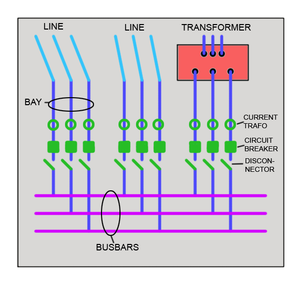
|
Szary: Podstacja Jasnoniebieski: Linia energetyczna Niebieski: Bay Zielony: Rozłączniki itd Różowy: Szyna Czerwony: Transformator |
Rozdzielnia
The switchgear assembly comprises one or more busbar assemblies and a number of bays each connecting a circuit to the busbar assembly. Normally the busbars and bays should be mapped individually, see below. However, sometimes the layout of the switchgear is not known, such as when the switchgear is inside a building or when no good aerial imagery is available. In such cases the switchgear may be mapped as an area. Only map switchgear in this way if it cannot be mapped in more details. If the entire substation is located indoor don't map the switchgear separately.
| Key | Value | Comment | Recommendation |
|---|---|---|---|
| power | switchgear | Defines this |
mandatory |
| voltage | <voltage> | The voltage of the switchgear | recommended |
| location | <location> | The location of the switchgear, for example indoor. See above for possible values. | recommended |
| gas_insulated | yes | Use this tag for gas insulated switchgear using pressurized SF6 or SF6/nitrogen gas as insulation medium. | optional |
Busbar
The busbar assembly makes connection to one or more circuits via the attached bays. The assembly comprises either rigid tubular conductors or flexible conductors. Strictly spoken, the term busbar refers to just one conductor but commonly an assembly of three busbars is also called a busbar [2]] which is the definition used here.
| Key | Value | Comment | Recommendation |
|---|---|---|---|
| power | line | Defines this |
mandatory |
| line | busbar | Identifies the line as a busbar assembly | mandatory |
| cables | <3,6,..> | Number of individual conductors. It is recommended to map each three-phase busbar assembly individually. However, if double or triple busbars for some reasons are mapped as a single way the cables tag should be used to indicate this fact. | recommended |
| voltage | <voltage> | The voltage of the busbar | recommended |
Bay
A bay connects an incoming circuit (power line, transformer, etc) to a busbar assembly. Each bay typically comprises circuit breakers, disconnectors, instrument transformers and surge arresters. It is suggested not to tag all these individual components. However, the circuit breaker may optionally be tagged as a switch.
| Key | Value | Comment | Recommendation |
|---|---|---|---|
| power | line | Defines this |
mandatory |
| line | bay | Identifies the line as a bay | mandatory |
| cables | <3,6,..> | Normally bays should be mapped individually per circuit. However, if for some reasons the mapped |
recommended |
| voltage | <voltage> | The voltage of the bay | recommended |
Switch
A switch normally comprises a circuit breaker and is mostly found within bays but may also be used between busbar sections. Tag a ![]() as power=switch.
as power=switch.
Transformer
A power transformer is a static piece of apparatus with two or more windings which, by electromagnetic induction, transforms a system of alternating voltage and current into another system of voltage and current for the purpose of transmitting electrical power [3]
See power=transformer for more information and details about tagging.
Converter
An HVDC converter converts electric power from high voltage alternating current (AC) to high-voltage direct current (HVDC), or vice-versa.
An HVDC converter plant comprises several components. The valve hall comprises the converter itself. Further components include a DC smoothing reactor, converter transformers, AC switch gear, harmonic filters and reactive power compensation. See below for compensation components. The converter itself may be tagged as follows:
| Key | Value | Comment | Recommendation |
|---|---|---|---|
| power | converter | Defines this node |
mandatory |
| converter | lcc | A line commutated converter (LCC) uses thyristor based valves and is the most common type. This is the default value. | recommended |
| vsc | A newer type is the transistor-based voltage source converter (VSC). | recommended | |
| back-to-back | A back-to-back converter couples two AC networks that are not synchronous or operate at different frequencies. There is no external DC power transmission link | recommended | |
| voltage | <DC voltage> | The voltage of the DC transmission in volt | recommended |
| poles | monopole / bipole | The number of poles. | recommended |
| rating | <power> MW | The power rating of the converter in MW (megawatt) | recommended |
General tags like name=* and operator=* may also be added.
Compensator
Various components are used for controlling reactive power and voltage quality in a power grid. Here are some suggested tags for different types of compensators.
| Key | Value | Comment | Recommendation |
|---|---|---|---|
| power | compensator | Defines this node |
mandatory |
| compensator | <compensator type> | See below for possible values. This tag should be specified when the compensator type is known | recommended |
| voltage | <voltage> | The voltage at which the compensator is operated | recommended |
| rating | <power> Mvar/kvar | The power rating of the compensator. The unit should be Mvar (megavolt-ampere-reactive) or kvar (kilovolt-ampere-reactive) | recommended |
| Key | Value | Comment |
|---|---|---|
| compensator | shunt_reactor | A shunt reactor absorbs excess reactive power. It looks like a transformer but has no secondary terminals. |
| shunt_capacitor | A shunt capacitor bank generates reactive power | |
| static_var | A static var compensator (SVC) comprises a thyristor controlled reactor, normally a thyristor switched capacitor and often fixed or switched reactors and capacitor banks. | |
| statcom | A static synchronous compensator (STATCOM) is a transistor based compensator (its design is similar to a VSC converter, see above). | |
| synchronous_condenser | A synchronous condenser is a large rotating synchronous machine (similar to a generator) for generating or absorbing reactive power. | |
| filter | A harmonic filter is used to eliminate harmonic currents generated by an HVDC converter. These can be quite large and may appropriately be mapped as | |
| series_reactor | A series reactor is used for controlling load sharing between parallel power lines or for limiting short circuit currents. The smoothing reactor of an HVDC converter is also a series reactor. | |
| series_capacitor | A series capacitor is sometimes inserted in a long power line to increase the transmission capacity. |
Map representation
- area: The feature should be rendered as a gray area like the old power=sub_station tag.
- node: Some sort of lightning symbol traditionally used to indicate high voltage.
Examples
| Maperitive | OSM Carto | Tagging | Note |
|---|---|---|---|
| power=substation substation=converter name=Bjæverskov HVDC Kontek voltage=400000;132000 (valve hall) building=yes power=converter name=HVDC Kontek operator=Energinet.dk poles=monopole rating=600 MW voltage=400000 |
Bjæverskov HVDC substation in Denmark (northern terminal of Kontek HVDC connection). Bing imagery of the substation. |
| Zdjęcie | Tagi | OSM Carto | Opis |
|---|---|---|---|

|
voltage=380000;150000 substation=transmission name=380kV Bleiswijk operator=TenneT |
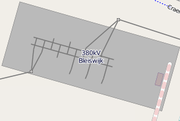
|
380 kV substation with three 380/150 kV transformers. Unusual for using outdoor gas insulated switchgear (GIS). |

|
voltage=25000;10000 substation=distribution location=indoor |
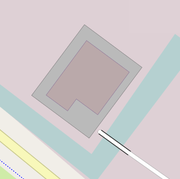
|
Indoor 25/10kV substation near The Hague. The entire fenced area should be mapped as a substation, not just the building. |
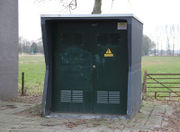
|
voltage=10000;400 substation=minor_distribution location=kiosk operator=Stedin |
An example of a small kiosk type substation. | |
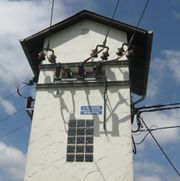
|
voltage=10000;400 substation=minor_distribution building=yes |
Characteristic tower type transformer building functioning as an electricity pole. Maybe tag the building as building=transformer_tower? |
Narzędzia używające ten schemat
- Maperitive power rule set do renderowania obiektów podstacji tego schematu w Maperitive.
Zobacz też
- Proposed_features/Substation_refinement: The approved substation proposal.




